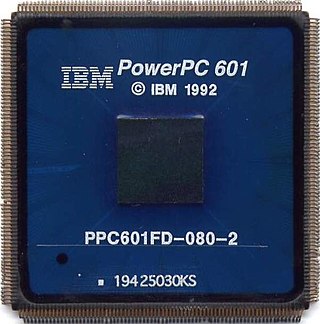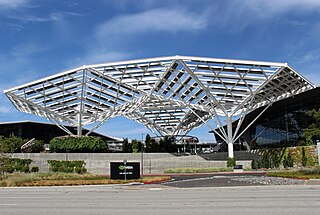Related Research Articles

Advanced Micro Devices, Inc. (AMD) is an American multinational corporation and technology company headquartered in Santa Clara, California and maintains significant operations in Austin, Texas. AMD is a hardware and fabless company that designs and develops central processing units (CPUs), graphics processing units (GPUs), field-programmable gate arrays (FPGAs), system-on-chip (SoC), and high-performance compute solutions. AMD serves a wide range of business and consumer markets, including gaming, data centers, artificial intelligence (AI), and embedded systems.

MIPS Tech LLC, formerly MIPS Computer Systems, Inc. and MIPS Technologies, Inc., is an American fabless semiconductor design company that is most widely known for developing the MIPS architecture and a series of RISC CPU chips based on it. MIPS provides processor architectures and cores for digital home, networking, embedded, Internet of things and mobile applications.

PowerPC is a reduced instruction set computer (RISC) instruction set architecture (ISA) created by the 1991 Apple–IBM–Motorola alliance, known as AIM. PowerPC, as an evolving instruction set, has been named Power ISA since 2006, while the old name lives on as a trademark for some implementations of Power Architecture–based processors.

In electronics and computer science, a reduced instruction set computer (RISC) is a computer architecture designed to simplify the individual instructions given to the computer to accomplish tasks. Compared to the instructions given to a complex instruction set computer (CISC), a RISC computer might require more instructions in order to accomplish a task because the individual instructions are written in simpler code. The goal is to offset the need to process more instructions by increasing the speed of each instruction, in particular by implementing an instruction pipeline, which may be simpler to achieve given simpler instructions.

Nvidia Corporation is an American multinational corporation and technology company headquartered in Santa Clara, California, and incorporated in Delaware. Founded in 1993 by Jensen Huang, Chris Malachowsky, and Curtis Priem, it is a software and fabless company which designs and supplies graphics processing units (GPUs), application programming interfaces (APIs) for data science and high-performance computing, and system on a chip units (SoCs) for mobile computing and the automotive market. Nvidia is also a dominant supplier of artificial intelligence (AI) hardware and software.
ARM is a family of RISC instruction set architectures (ISAs) for computer processors. Arm Holdings develops the ISAs and licenses them to other companies, who build the physical devices that use the instruction set. It also designs and licenses cores that implement these ISAs.
OpenRISC is a project to develop a series of open-source hardware based central processing units (CPUs) on established reduced instruction set computer (RISC) principles. It includes an instruction set architecture (ISA) using an open-source license. It is the original flagship project of the OpenCores community.

Micron Technology, Inc. is an American producer of computer memory and computer data storage including dynamic random-access memory, flash memory, and solid-state drives (SSDs). It is headquartered in Boise, Idaho. Micron's consumer products, including the Ballistix line of consumer & gaming memory modules, are marketed under the Crucial brand. Micron and Intel together created IM Flash Technologies, which produced NAND flash memory. It owned Lexar between 2006 and 2017. Micron is the only U.S.-based manufacturer of memory.
The transistor count is the number of transistors in an electronic device. It is the most common measure of integrated circuit complexity. The rate at which MOS transistor counts have increased generally follows Moore's law, which observes that transistor count doubles approximately every two years. However, being directly proportional to the area of a die, transistor count does not represent how advanced the corresponding manufacturing technology is. A better indication of this is transistor density which is the ratio of a semiconductor's transistor count to its die area.

Cadence Design Systems, Inc. is an American multinational technology and computational software company. Headquartered in San Jose, California, Cadence was formed in 1988 through the merger of SDA Systems and ECAD. Initially specialized in electronic design automation (EDA) software for the semiconductor industry, currently the company makes software and hardware for designing products such as integrated circuits, systems on chips (SoCs), printed circuit boards, and pharmaceutical drugs, also licensing intellectual property for the electronics, aerospace, defense and automotive industries, among others.

Tegra is a system on a chip (SoC) series developed by Nvidia for mobile devices such as smartphones, personal digital assistants, and mobile Internet devices. The Tegra integrates an ARM architecture central processing unit (CPU), graphics processing unit (GPU), northbridge, southbridge, and memory controller onto one package. Early Tegra SoCs are designed as efficient multimedia processors. The Tegra-line evolved to emphasize performance for gaming and machine learning applications without sacrificing power efficiency, before taking a drastic shift in direction towards platforms that provide vehicular automation with the applied "Nvidia Drive" brand name on reference boards and its semiconductors; and with the "Nvidia Jetson" brand name for boards adequate for AI applications within e.g. robots or drones, and for various smart high level automation purposes.

Arm Holdings plc is a British semiconductor and software design company based in Cambridge, England, whose primary business is the design of central processing unit (CPU) cores that implement the ARM architecture family of instruction sets. It also designs other chips, provides software development tools under the DS-5, RealView and Keil brands, and provides systems and platforms, system-on-a-chip (SoC) infrastructure and software. As a "holding" company, it also holds shares of other companies. Since 2016, it has been majority owned by Japanese conglomerate SoftBank Group.

POWER8 is a family of superscalar multi-core microprocessors based on the Power ISA, announced in August 2013 at the Hot Chips conference. The designs are available for licensing under the OpenPOWER Foundation, which is the first time for such availability of IBM's highest-end processors.
IBM Power microprocessors are designed and sold by IBM for servers and supercomputers. The name "POWER" was originally presented as an acronym for "Performance Optimization With Enhanced RISC". The Power line of microprocessors has been used in IBM's RS/6000, AS/400, pSeries, iSeries, System p, System i, and Power Systems lines of servers and supercomputers. They have also been used in data storage devices and workstations by IBM and by other server manufacturers like Bull and Hitachi.
The OpenPOWER Foundation is a collaboration around Power ISA-based products initiated by IBM and announced as the "OpenPOWER Consortium" on August 6, 2013. IBM's focus is to open up technology surrounding their Power Architecture offerings, such as processor specifications, firmware, and software with a liberal license, and will be using a collaborative development model with their partners.
RISC-V is an open standard instruction set architecture (ISA) based on established reduced instruction set computer (RISC) principles. The project began in 2010 at the University of California, Berkeley, transferred to the RISC-V Foundation in 2015, and on to RISC-V International, a Swiss non-profit entity, in November 2019. Like several other RISC ISAs, e.g. Amber (ARMv2) or OpenRISC, RISC-V is offered under royalty-free open-source licenses. The documents defining the RISC-V instruction set architecture (ISA) are offered under a Creative Commons license or a BSD License.

SiFive, Inc. is an American fabless semiconductor company and provider of commercial RISC-V processors and silicon chips based on the RISC-V instruction set architecture (ISA). Its products include cores, SoCs, IPs, and development boards.
Codasip is a processor technology company enabling system-on-chip developers to differentiate their products. The company specializes in RISC-V processor technologies and offers Codasip Studio, a tool suite for processor design using the CodAL architecture description language.
References
- 1 2 "The RISC-V Foundation Appoints Calista Redmond as Chief Executive Officer". www.businesswire.com. 2019-03-12. Retrieved 2020-12-15.
- 1 2 "Calista Redmond | Design Automation Conference". dac.com. Retrieved 2020-12-15.
- ↑ "Will RISC-V be a contender now that Nvidia is buying Arm?". VentureBeat. 2020-09-27. Retrieved 2020-12-15.
- ↑ "The world is big enough! - Calista Redmond, CEO RISC-V". eeNews Embedded. 2020-03-01. Retrieved 2020-12-15.
- ↑ "'RISC-V is ushering in a new era of silicon design and processor innovation' - Press". HiPEAC. Retrieved 2020-12-15.
- ↑ "RISC-V: Calista Redmond interview". ArchiTecnologia (in Spanish). 2020-02-05. Retrieved 2020-12-15.
- ↑ "Week In Review: Design, Low Power". Semiconductor Engineering. 2020-12-11. Retrieved 2020-12-15.
- ↑ "RISC-V grows globally as an alternative to Arm and its license fees". VentureBeat. 2019-12-11. Retrieved 2020-12-15.
- ↑ Dahad, Nitin (2020-09-18). "RISC-V speaks on options after Nvidia-Arm news". Embedded.com. Retrieved 2020-12-15.
- ↑ Manners, David (2019-11-26). "RISC-V Foundation moves to Switzerland". Electronics Weekly. Retrieved 2020-12-15.
- ↑ "RISC-V Foundation headquarters has officially moved to Switzerland - Code World". www.codetd.com. Retrieved 2020-12-15.
- ↑ Alper, Stephen Nellis, Alexandra (2019-11-26). "U.S.-based chip-tech group moving to Switzerland over trade curb fears". Reuters. Retrieved 2020-12-15.
{{cite news}}: CS1 maint: multiple names: authors list (link)